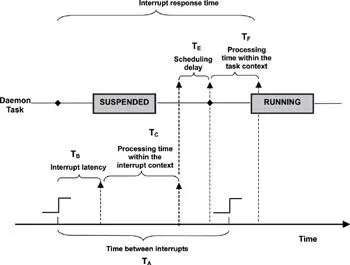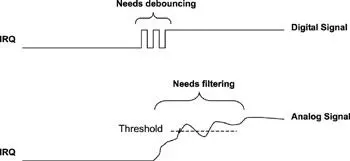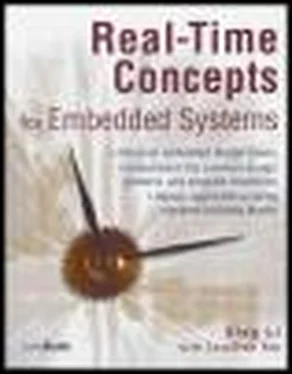There are two main reasons to partition the ISR into two pieces. One is to reduce the processing time within the interrupt context. The other is a bit more complex in that the architecture treats the interrupt as having higher priority than a running task, but in practice that might not be the case. For example, if the device that controls the blinking of an LED reports a failure, it is definitely lower in priority than a task that must send a communication reply to maintain its connection with the peer. If the ISR for this particular interrupt were partitioned into two sections, the daemon task that continues the LED interrupt processing can have a lower task priority than the other task. This factor allows the other higher priority task to complete with limited impact. Figure 10.10 illustrates this concept.

Figure 10.10: Interrupt processing in two contexts.
The benefits to this concept are the following:
· Lower priority interrupts can be handled with less priority than more critical tasks running in the system.
· This approach reduces the chance of missing interrupts.
· This approach affords more concurrency because devices are being serviced minimally so that they can continue operations while their previous requests are accumulated without loss to the extent allowed by the system.
On the other hand, the interrupt response time increases, because now the interrupt response time is T D= T B+ T C+ T E+ T F . The increase in response time is attributed to the scheduling delay, and the daemon task might have to yield to higher priority tasks.
The scheduling delay happens when other higher priority tasks are either running or are scheduled to run. The scheduling delay also includes the amount of time needed to perform a context switch after the daemon task is moved from the ready queue to the run queue.
In conclusion, the duration of the ISR running in the context of the interrupt depends on the number of interrupts and the frequency of each interrupt source existing in the system. Although general approaches to designing an ISR exist, no one solution exists to implement an ISR so that it works in all embedded designs. Rather the embedded systems developer must design an ISR according to the considerations discussed in this section.
General Guides
On architectures where interrupt nesting is allowed:
· An ISR should disable interrupts of the same level if the ISR is non-reentrant.
· An ISR should mask all interrupts if it needs to execute a sequence of code as one atomic operation.
· An ISR should avoid calling non-reentrant functions. Some standard library functions are non-reentrant, such as many implementations of malloc and printf. Because interrupts can occur in the middle of task execution and because tasks might be in the midst of the "malloc" function call, the resulting behavior can be catastrophic if the ISR calls this same non-reentrant function.
· An ISR must never make any blocking or suspend calls. Making such a call might halt the entire system.
If an ISR is partitioned into two sections with one section being a daemon task, the daemon task does not have a high priority by default. The priority should be set with respect to the rest of the system.
10.6 The Nature of Spurious Interrupts
A spurious interrupt is a signal of very short duration on one of the interrupt input lines, and it is likely caused by a signal glitch.
An external device uses a triggering mechanism to raise interrupts to the core processor. Two types of triggering mechanisms are level triggering and edge triggering . Figure 10.11 illustrates the variants of edge triggers (rising edge or falling edge). This kind of triggering is typically used with a digital signal.

Figure 10.11: Edge triggering on either rising or falling edge.
In contrast, level triggering is commonly used in conjunction with an analog signal. Figure 10.12 illustrates how level triggering might be implemented in a design. It is important to note that when using level triggering, the PIC or microcontroller silicon typically defines the trigger threshold value.

Figure 10.12: Level triggering.
How do spurious interrupts occur? In real-world situations, digital and analog signals are not as clean as portrayed here. The environment, types of sensors or transducers, and the method in which wiring is laid out in an embedded design all have a considerable effect on how clean the signal might appear. For example, a digital signal from a switch might require debouncing, or an analog signal might need filtering. Figure 10.13 provides a good illustration of how both digital and analog signals can really look. While electronic methods for debouncing and filtering fall beyond the realm of this book, it is important nonetheless to understand that input signals, whether for interrupts or other inputs, might not be as clean as a developer might envision them. These signals, therefore, can represent a potential source for sporadic behavior.

Figure 10.13: Real signals.
As can be seen, one reason for the occurrence of spurious interrupts is unstableness of the interrupt signal. Spurious interrupts can be caused when the processor detects errors while processing an interrupt request. The embedded systems programmer must be aware of spurious interrupts and know that spurious interrupts can occur and that this type of interrupt must be handled as any other type of interrupts. The default action from the kernel is usually sufficient.
Some points to remember include the following:
· Exceptions are classified into synchronous and asynchronous exceptions.
· Exceptions are prioritized.
· External interrupts belong to the category of asynchronous exceptions.
· External interrupts are the only exceptions that can be disabled by software.
· Exceptions can be nested.
· Using a dedicated exception frame is one solution to solving the stack overflow problem that nested exceptions cause.
· Exception processing should consider the overall timing requirements of the system devices and tasks.
· Spurious interrupts can occur and should be handled as any other interrupts.
Chapter 11: Timer and Timer Services
In embedded systems, system tasks and user tasks often schedule and perform activities after some time has elapsed. For example, a RTOS scheduler must perform a context switch of a preset time interval periodically-among tasks of equal priorities-to ensure execution fairness when conducting a round-robin scheduling algorithm. A software-based memory refresh mechanism must refresh the dynamic memory every so often or data loss will occur. In embedded networking devices, various communication protocols schedule activities for data retransmission and protocol recovery. The target monitor software sends system information to the host-based analysis tool periodically to provide system-timing diagrams for visualization and debugging.
In any case, embedded applications need to schedule future events. Scheduling future activities is accomplished through timers using timer services.
Читать дальше
















